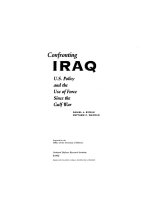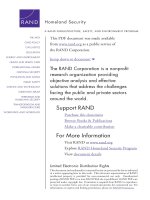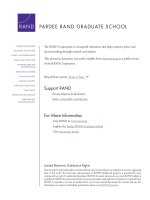Stealing the Sword - Limiting Terrorist Use of Advanced Conventional Weapons pot
Bạn đang xem bản rút gọn của tài liệu. Xem và tải ngay bản đầy đủ của tài liệu tại đây (2.99 MB, 156 trang )
This document and trademark(s) contained herein are protected by law as indicated
in a notice appearing later in this work. This electronic representation of RAND
intellectual property is provided for non-commercial use only. Unauthorized
posting of RAND PDFs to a non-RAND Web site is prohibited. RAND PDFs are
protected under copyright law. Permission is required from RAND to reproduce,
or reuse in another form, any of our research documents for commercial use. For
information on reprint and linking permissions, please see RAND Permissions.
Limited Electronic Distribution Rights
Visit RAND at www.rand.org
Explore RAND Homeland Security Program
View document details
For More Information
This PDF document was made available
from www.rand.org as a public service of
the RAND Corporation.
6
Jump down to document
THE ARTS
CHILD POLICY
CIVIL JUSTICE
EDUCATION
ENERGY AND ENVIRONMENT
HEALTH AND HEALTH CARE
INTERNATIONAL AFFAIRS
NATIONAL SECURITY
POPULATION AND AGING
PUBLIC SAFETY
SCIENCE AND TECHNOLOGY
SUBSTANCE ABUSE
TERRORISM AND
HOMELAND SECURITY
TRANSPORTATION AND
INFRASTRUCTURE
WORKFORCE AND WORKPLACE
The RAND Corporation is a nonprofit
research organization providing
objective analysis and effective
solutions that address the challenges
facing the public and private sectors
around the world.
Purchase this document
Browse Books & Publications
Make a charitable contribution
Support RAND
This product is part of the RAND Corporation monograph series.
RAND monographs present major research findings that address the
challenges facing the public and private sectors. All RAND mono-
graphs undergo rigorous peer review to ensure high standards for
research quality and objectivity.
Limiting Terrorist Use of
Advanced Conventional Weapons
James Bonomo
Giacomo Bergamo
David R. Frelinger
John Gordon IV
Brian A. Jackson
Stealing
Sword
the
Prepared for the Department of Homeland Security
The RAND Corporation is a nonprofit research organization providing
objective analysis and effective solutions that address the challenges
facing the public and private sectors around the world. RAND’s
publications do not necessarily reflect the opinions of its research clients
and sponsors.
R
®
is a registered trademark.
© Copyright 2007 RAND Corporation
All rights reserved. No part of this book may be reproduced in any
form by any electronic or mechanical means (including photocopying,
recording, or information storage and retrieval) without permission in
writing from RAND.
Published 2007 by the RAND Corporation
1776 Main Street, P.O. Box 2138, Santa Monica, CA 90407-2138
1200 South Hayes Street, Arlington, VA 22202-5050
4570 Fifth Avenue, Suite 600, Pittsburgh, PA 15213-2665
RAND URL:
To order RAND documents or to obtain additional information, contact
Distribution Services: Telephone: (310) 451-7002;
Fax: (310) 451-6915; Email:
Library of Congress Cataloging-in-Publication Data
Stealing the sword : limiting terrorist use of advanced conventional weapons /
James Bonomo [et al.].
p. cm.
“MG-510”—Back cover.
Includes bibliographical references.
ISBN-13: 978-0-8330-3965-1 (pbk. : alk. paper)
1. Weapons systems. 2. Arms control. 3. Terrorism—Prevention. 4. Terrorism—
United States—Prevention. I. Bonomo, James. II. Rand Corporation.
UF500.S84 2007
363.325'16—dc22
2006017948
Cover design by Peter Soriano
The research described in this report was sponsored by the
U.S. Department of Homeland Security, Science and Technology
Directorate, Office of Comparative Studies, under the auspices of the
Homeland Security Program within RAND Infrastructure, Safety, and
Environment (ISE), a division of the RAND Corporation.
iii
Preface
In this document, we focus on how the United States can shape the
environment, including the perceptions of terrorists, to discourage
the use of advanced conventional weapons. We review weapons under
development, assess prospective and previous terrorist uses of such
weapons, identify ways to make particular kinds of weapons less attrac-
tive to terrorist groups, and explore reasons that terrorist groups choose
or reject certain weapons.
e analyses presented here should be of interest to homeland
security policymakers who need to understand the threat posed by
advanced conventional weapons. ose concerned with developing
security or defensive systems can allocate research and development
and technology funding to countermeasures and defense systems with
the greatest possible potential payoff. ose concerned with training
security forces can adjust their curricula and concepts appropriately.
And those interested in limiting the access of terrorists to advanced
weapons can learn where to focus their efforts. Overall, these efforts
should influence terrorist decisionmaking, deterring their use of par-
ticular weapons. Related RAND Corporation publications include the
following:
Brian A. Jackson, John C. Baker, Peter Chalk, Kim Cragin, John t
V. Parachini, and Horacio R. Trujillo, Aptitude for Destruction,
Vol. 1: Organizational Learning in Terrorist Groups and Its Impli-
cations for Combating Terrorism (MG-331-NIJ, 2005)
Brian A. Jackson, John C. Baker, Peter Chalk, Kim Cragin, John t
V. Parachini, and Horacio R. Trujillo, Aptitude for Destruction,
iv Stealing the Sword: Limiting Terrorist Use of Advanced Conventional Weapons
Vol. 2: Case Studies of Organizational Learning in Five Terrorist
Groups (MG-332-NIJ, 2005)
Kim Cragin and Sara A. Daly, t e Dynamic Terrorist reat: An
Assessment of Group Motivations and Capabilities in a Changing
World (MR-1782-AF, 2004)
James S. Chow, James Chiesa, Paul Dreyer, Mel Eisman, eo-t
dore W. Karasik, Joel Kvitky, Sherrill Lingel, David Ochmanek,
and Chad Shirley, Protecting Commercial Aviation Against the
Shoulder-Fired Missile reat (OP-106-RC, 2005).
is monograph is one component of a series of studies exam-
ining the technology competition between security organizations and
terrorist organizations, a critical battleground in the war against terror-
ism. is series focuses on understanding how terrorist groups make
technology choices and how they respond to the technologies deployed
against them. is research was sponsored by the U.S. Department
of Homeland Security, Science and Technology Directorate, Office of
Comparative Studies.
The RAND Homeland Security Program
is research was conducted under the auspices of the Homeland Secu-
rity Program within RAND Infrastructure, Safety, and Environment
(ISE). e mission of ISE is to improve the development, operation,
use, and protection of society’s essential physical assets and natural
resources and to enhance the related social assets of safety and secu-
rity of individuals in transit and in their workplaces and communi-
ties. Homeland Security Program research supports the Department
of Homeland Security and other agencies charged with preventing and
mitigating the effects of terrorist activity within U.S. borders. Projects
address critical infrastructure protection, emergency management, ter-
rorism risk management, border control, first responders and prepared-
ness, domestic threat assessments, domestic intelligence, and workforce
and training.
Questions or comments about this monograph should be sent to
the project leader, Brian Jackson (). Infor-
mation about the Homeland Security Program is available online
( Inquiries about homeland security
research projects should be sent to the following address:
Michael Wermuth, Director
Homeland Security Program, ISE
RAND Corporation
1200 South Hayes Street
Arlington, VA 22202-5050
703-413-1100, x5414
Preface v
Contents
vii
Preface iii
Figures
xi
Tables
xiii
Summary
xv
Acknowledgments
xxiii
Abbreviations
xxv
CHAPTER ONE
Introduction 1
Study Approach
3
CHAPTER TWO
What Types of Advanced Military Weapons Could Become
Available to Terrorists?
7
Advanced Small Arms
8
Technological Advance: Airburst Assault Weapons with Smart
Ammo
10
Technological Advance: Metal Storm’s 100 Percent Electronic
Firing Mechanism
17
Mortar Systems
20
Technological Advance: Gliding and Rocketing to Longer Range
22
Technological Advance: Nonballistic Flight rough rusters and
Control Fins
27
Technological Advance: “Fire-and-Forget” IR- and RF-Homing
Termina l Guidance
28
Technological Advance: Laser and Fiber-Optic Man-in-the-Loop
Termina l Guidance
29
Technological Advance: GPS-Based Computer Aids, Integration,
and GPS-Only Guidance
32
Technological Advance: Lightweight Materials and Design
Changes to Increase Speed
36
Technological Advance: Greater Penetration, Greater Area Coverage
37
Conclusion
37
Sniper Systems
39
Technological Advance: Ballistics Computers
41
Technological Advance: Remote Aiming Platforms
47
Technological Advance: Enhanced Scopes and Reticules
49
Technological Advance: Long-Range Night Vision for Snipers
50
Technological Advance: Rangefinders
51
Technological Advance: Environmental Sensors
52
Antitank Guided Weapons
54
Man-Portable Antiarmor Weapons
56
Limpet Mines
58
Advanced Land Mines
60
Night Vision
61
Technological Advance: Four Generations of Light Intensification
61
Technological Advance: Seeing Heat
62
CHAPTER THREE
What Advanced Conventional Weapons Are Potentially Most
Useful and Attractive to Terrorists?
63
Game-Changing Weapons
64
Terrorist Scenarios Involving Advanced Conventional Weapons
66
Mortar Attacks
66
Attack on the Rose Bowl: A Scenario
71
Sniper Attacks
75
Attacks Using Advanced Small Arms
76
Attacks Using Antitank Guided Weapons
77
Attacks Using Limpet Mines
79
viii Stealing the Sword: Limiting Terrorist Use of Advanced Conventional Weapons
Comparing the Most reatening Advanced Conventional Weapons 79
CHAPTER FOUR
What Opportunities Exist for Controlling Weapons of Particular
Concern?
81
Types of Use Controls
81
Policy and Procedural Controls
84
Technica l Controls
87
A Conceptual Design of a Use Control System
91
Combining Policy, Procedures, and Technical Solutions
96
CHAPTER FIVE
How Might Use Controls Deter Terrorist Organizations? 99
e Benefits, Costs, and Risks of Adopting Advanced Conventional
Weapons
100
Benefits Drive the Adoption Process
102
Cost Considerations
103
Risks in Acquiring New Technologies
104
Potential Impacts of Weapon Control Measures
106
Conclusions
109
CHAPTER SIX
Observations and Implications 111
Bibliography
117
Contents ix
Figures
xi
2.1. A Soldier Aims an XM25 11
2.2. Components of the XM104 TA/FC for Use with the
XM25
12
2.3. XM104 Sighting System and Ballistics Computer in Action
13
2.4. Accurately Modeled XM25 in America’s Army
14
2.5. XM25’s Fire Control Screen Simulated in America’s Army
15
2.6. e XM307 Has Many Similarities to the XM25
16
2.7. A Soldier Test Fires the AICW
17
2.8. Diagram of the AICW
19
2.9. A Four-Barreled Concept Handgun
20
2.10. XM984 Uses a Rocket Motor to Reach Up to 11 km
24
2.11. Israel Aircraft Industries’ Fireball Has Four Deployable
Wings as Do the PGMM and Armement Léger à Fibre
Optique (ALFO)
24
2.12. e Components and Flight Profile of ATK’s PGMM
26
2.13. One-Shot Defeat Is Possible for Some Precision Mortars
31
2.14. Rockwell Collins’ PLGR+GLS in Use
34
2.15. A Handheld Personal Lightweight GPS Receiver (PLGR)
35
2.16. e Mechem MFCS in Use with a 60mm Mortar
36
2.17. A Common Sniper Scope Features Knobs at Allow a
Shooter to Adjust for Elevation and Windage
43
2.18. e Input Screens on Horus Vision’s Basic Ballistics
Computer, the ATrag1P, Are Easy to Understand and
Navigate
45
2.19. e Main Screen on the ATrag1P
45
2.20. e Horus Vision Complete Targeting System
46
2.21. e Components of the TRAP System
47
xii Stealing the Sword: Limiting Terrorist Use of Advanced Conventional Weapons
2.22. e BAC Allows Both Eyes to Stay Open While Using a
Magnified Scope
50
2.23. e Kestrel 4000 Is Small, Cheap, and Useful to Snipers
53
2.24. Russian-Built AT-4 Spigot, an Antitank Guided Missile
and Launcher
55
2.25. e RPG-7 Antitank Grenade Launcher
57
2.26. Magnetic Limpet Mine
59
3.1. Potential Terrorist Targets by Degree of Public
Accessibility
65
3.2. Mortar Attacks Since 1998, by Region
68
3.3. Mortar Attacks Staged Between January 1998 and June
2005
69
3.4. Potential Baseplate Site
72
4.1. Exemplar Life Cycle of Advanced Munitions
83
4.2. Use Control Application Domains
85
Tables
xiii
2.1. Capabilities of Sniper Ballistics Computers in
Compensating for Target and Environmental Properties
42
5.1. Factors Affecting Technology Adoption Decisions
101
xv
Summary
is book examines one manifestation of the general technical com-
petition between terrorist groups and security organizations—the bal-
ance between the potential use by terrorists of advanced conventional
weapons and the responses available to deter or counter them. Our use
of the term advanced conventional weapons is inclusive and broad: any
new or unusual conventional weaponry developed for ordinary military
forces. Such weaponry seems a priori likely to be particularly threat-
ening in the hands of terrorists. All weaponry is obviously designed
to do damage, but new design features might enable new, or at least
unfamiliar, terrorist attacks. At the same time, the usual limitation of
weaponry to militaries implies that various controls could be applied,
albeit less stringently than controls imposed upon nuclear, chemi-
cal, or biological weapons. Consequently, the competition involving
advanced conventional weaponry seems both complex and potentially
important.
One example of this competition has received much attention—
the balance between terrorist use of man-portable air defense systems
(MANPADS) and U.S. responses. e November 2002 attacks in
Mombasa, Kenya, using Russian-built MANPADS against an Israeli
airliner, demonstrated that terrorists are able to acquire and use that
type of advanced weaponry.
1
In response, the United States has negoti-
ated a multinational agreement that calls for imposing both technical
and procedural use controls on new MANPADS through an expansion
1
Bayles (2003).
xvi Stealing the Sword: Limiting Terrorist Use of Advanced Conventional Weapons
in scope of the Wassenaar Arrangement.
2
e United States has also
started a pilot program within the Department of Homeland Secu-
rity to demonstrate technical countermeasures suitable for protecting
commercial aircraft from MANPADS.
3
But MANPADS are only one
of a long list of advanced conventional weapons that are potentially
attractive to terrorists. is monograph explores a range of other weap-
ons, both those still under development and those already available
but relatively unused by terrorists. e monograph identifies those
weapons that require greater attention from U.S. homeland security
decisionmakers and outlines a number of actions that can mitigate the
use of these weapons by terrorists.
Key Weapons of Concern
is project identified five types of advanced conventional weapons
that could, in the absence of mitigating measures, provide terrorists
with a qualitatively new and different capability. Each of these weapon
types threatens in some sense to change the nature of terrorist attacks:
sniper rifles and associated instrumentationt
improved squad-level weapons of several typest
long-range antitank missilest
large limpet minest
precision indirect fire systems.t
Sniper rifles and especially their electronic support equipment
allow a relatively unskilled marksman a reasonable chance of assas-
sinating an individual from great ranges—up to 2 km—which can be
well outside the area that a security force guarding an official would
consider threatening.
2
Wassenaar Arrangement on Export Controls for Conventional Arms and Dual-
Use Goods and Technologies (2003).
3
U.S. Department of Homeland Security (2004).
xvi
Improved squad-level weapons could provide a terrorist assault
force with a variety of new abilities, from individual indirect fire to the
ability to eliminate a strong point with a short-range, antitank weapon.
Advanced armor-piercing ammunition is available for many rifles and
will easily penetrate standard body armor.
Long-range, antitank weapons can destroy any vehicle and kill its
occupants from beyond 2 km. ese same weapons can also destroy a
small building or speaking platform. Advanced versions of these weap-
ons are further reducing demands on the operator, which may make
these weapons highly attractive to terrorists.
Large limpet mines attached to a ship’s hull have the capability
to sink large, oceangoing vessels. Even smaller, more common limpet
mines can sink small ships; in fact, if multiple mines are carefully
emplaced, these small mines can also sink large ships. In particular,
cruise ships and ferries would be vulnerable to such devices, placing
their many passengers at risk. Such external mines would, of course,
not be detected during conventional cargo and passenger inspections.
Finally, precision indirect fire systems—primarily advanced mor-
tars—can enable a wide range of new terrorist attacks: on crowds in
outdoor venues; on valuable physical targets, such as refineries or air-
craft; and on officials or other individuals appearing at known loca-
tions, particularly in the open, such as at a press conference.
In all of these five cases, the new systems could enable the attack-
ers to surprise security forces. e attacks could come from far beyond
any controllable security perimeter, could allow a high probability of
escape for the terrorists, or could require only a single, small attack to
be effective.
Reducing the Threat by Raising Awareness
e first step in limiting the threat from these systems is to raise aware-
ness of the threat. In all cases, key groups need to understand the capa-
bilities provided by these systems. Awareness of the new capabilities
should allow technical or operational changes by security forces. Such
Summary xviiSummary xvii
xviii Stealing the Sword: Limiting Terrorist Use of Advanced Conventional Weapons
efforts may include the following key groups and threat mitigation
measures:
Personal protective services, such as the U.S. Secret Service, whose t
job it is to guard high-profile individuals, need to realize that
snipers and antitank weapons can make lethal line-of-sight strikes
from over 2 km away. ey also need to realize that non–line-
of-sight weapons, such as precision mortars, will soon allow very
long-range, precise attacks on targets at known locations. is
awareness should enable protective services to reduce opportuni-
ties for terrorist to make use of such weapons.
Guard forces at sites and facilities need to be aware of the capa-t
bilities that new, squad-level weapons would provide to an assault
force attacking them. For example, the addition of precise, indi-
rect fire grenades should generate a greater concern with overhead
cover. New rocket-propelled grenades, thermobaric warheads,
and short-range antitank weapons will require enhanced fortifi-
cation at strong points. Even today, currently available small-arms
ammunition should motivate upgrades in guard forces’ personal
armor.
Operators of cruise ships and ferries—particularly oceangoing t
ferries—should be aware of the potential use and impact of large
limpet mines. is awareness should motivate the use of protec-
tive cordons and hull inspections before leaving port.
Reducing the Threat Through Procedural and Technical-
Use Controls
Beyond awareness are procedural and technical-use controls. Most
advanced conventional weapons are intended only for military use.
is means that basic procedural controls governing the use of military
systems will provide some limits on terrorist uses. We note two major
exceptions not under such controls: sniper rifles and their accessories
and advanced ammunition. For those weapons, only awareness and the
precautions taken by security forces can mitigate their threat.
Summary xix
All the other advanced systems will presumably be subject to
international procedural controls common to military systems; these
controls likely will slow their diffusion to terrorist groups. But, as the
preceding example of MANPADS clearly shows, even relatively expen-
sive, controlled systems can end up in terrorists’ hands.
Adding technical-use controls in many instances would represent
a major step—both organizationally and technologically. First, to be
effective, such technical controls require an international agreement.
e continuing, complex diplomatic efforts to enhance the controls
over MANPADS, where the threat has already been clearly demon-
strated, illustrate the scale of any new diplomatic effort that would be
required concerning other advanced weapons. We believe that to justify
and to motivate such an effort would require both an increased aware-
ness of the threatening weapon system and also readily implementable
technical controls. In our view, most of the systems do not meet these
two criteria.
One system, we assert, does meet both of the criteria—precision,
indirect fire systems based on an advanced mortar. Many terrorists
already have had some favorable experiences with mortars, notably
including those terrorists being trained in the ongoing Iraqi insur-
gency. Because future advanced mortar systems must depend on the
Global Positioning System (GPS) or an equivalent satellite system,
4
these precision, indirect fire systems also have technical features that
could facilitate various sorts of use controls. In particular, integrated
electronic systems involving GPS can be designed to require a “trusted
component,” which would be difficult for a terrorist group to circum-
vent. At the same time, this trusted component would serve as the key
element for technical controls. A range of limitations then becomes
feasible in principle, such as the imposition of expiration times or geo-
graphic boundaries beyond which the system would not function.
Importantly, these limits would be all but invisible to legitimate mili-
tary users, so they would add little operational burden. But the intent
4
Since GPS is the only widely available satellite navigation system today, the examples and
discussion in this book all refer to GPS. e arguments we make involving GPS would hold
for any similar satellite navigation system, however.
xx Stealing the Sword: Limiting Terrorist Use of Advanced Conventional Weapons
of these limitations would be to make them unreliable and unattractive
to most terrorist groups, particularly as unauthorized users would have
no way of checking the precise times, places, or circumstances in which
the system would fail.
e best time to implement such technical controls is when the
system is in its design phase. Controls added “on top,” after a design is
“frozen,” tend to be easier to circumvent. Fortunately, the most threat-
ening system we have identified—the GPS-guided mortar without ter-
minal guidance—is not yet in its development phase. is situation
creates an opportunity to consider ways to apply the appropriate con-
trols. We expect that this window of opportunity will close within the
next few years, however, because the military utility of and demand for
such a system will be high.
Steps for Moving Forward
e most worrisome advanced conventional weapons that we have
identified in this research are advanced, GPS-guided mortars. Only
these systems combine a significant, new capability for terrorists with
a lack of effective operational counters for security forces. We must
take advantage of a fleeting opportunity to design controls into the
weapons. is means that starting efforts to control advanced mor-
tars now is urgent. Although seemingly less threatening, the other
advanced weapons—sniper weapons, advanced small arms, antitank
guided weapons, and limpet mines—still do require some responses.
Most important, they require simple awareness on the part of security
forces, and also some new techniques, such as external searches of ships
before leaving port.
If the United States chooses to pursue opportunities to place
additional procedural and technical-use controls on precise, indirect
fire weapons, such as GPS-guided mortars, we believe that two initial
steps are called for. e first step is to begin diplomatic discussions
with the key producer nations, so that all the involved decisionmakers
and stakeholders begin evaluating potential terrorist uses of these sys-
tems. e second step is to commission a detailed study of the techni-
Summary xxi
cal modules and architecture needed to implement proposed tech-
nical controls. Such an investigation would be directed at determining
whether the existing technical modules would be sufficient or whether
they might need to be modestly expanded to include the required con-
trol functions.
e U.S. Department of Homeland Security can play a key role in
both these steps. Regarding the first step identified above, the depart-
ment has the primary responsibility for deterring terrorist attacks. It
could use that role, within the interagency process, to push for starting
diplomatic discussions. is may also entail changes in the interagency
system, such as permanently including the Department of Homeland
Security on interagency panels that are considering arms exports. For
the second step, the department could itself directly fund such a study,
perhaps in concert with the U.S. National Security Agency.
While there appears to be sufficient time to negotiate and develop
meaningful controls on GPS-guided mortars, that opportunity can be
lost if the United States does not begin the process soon. Missing this
opportunity would reduce the controls on these mortars to the exist-
ing procedural ones for military systems in general and so increase the
burden on security forces to plan around and counter such attacks.
Although that may be a sufficient response for the other weapon sys-
tems we have analyzed, it appears to us to be insufficient for limiting
the threat from these future, advanced mortars.
xxiii
Acknowledgments
e authors appreciate the thoughtful comments from our client,
Robert Ross; from the program director, Michael Wermuth; and from
our reviewers, James Chow and Peter Zimmerman. e resulting doc-
ument, of course, remains the sole responsibility of the authors.









